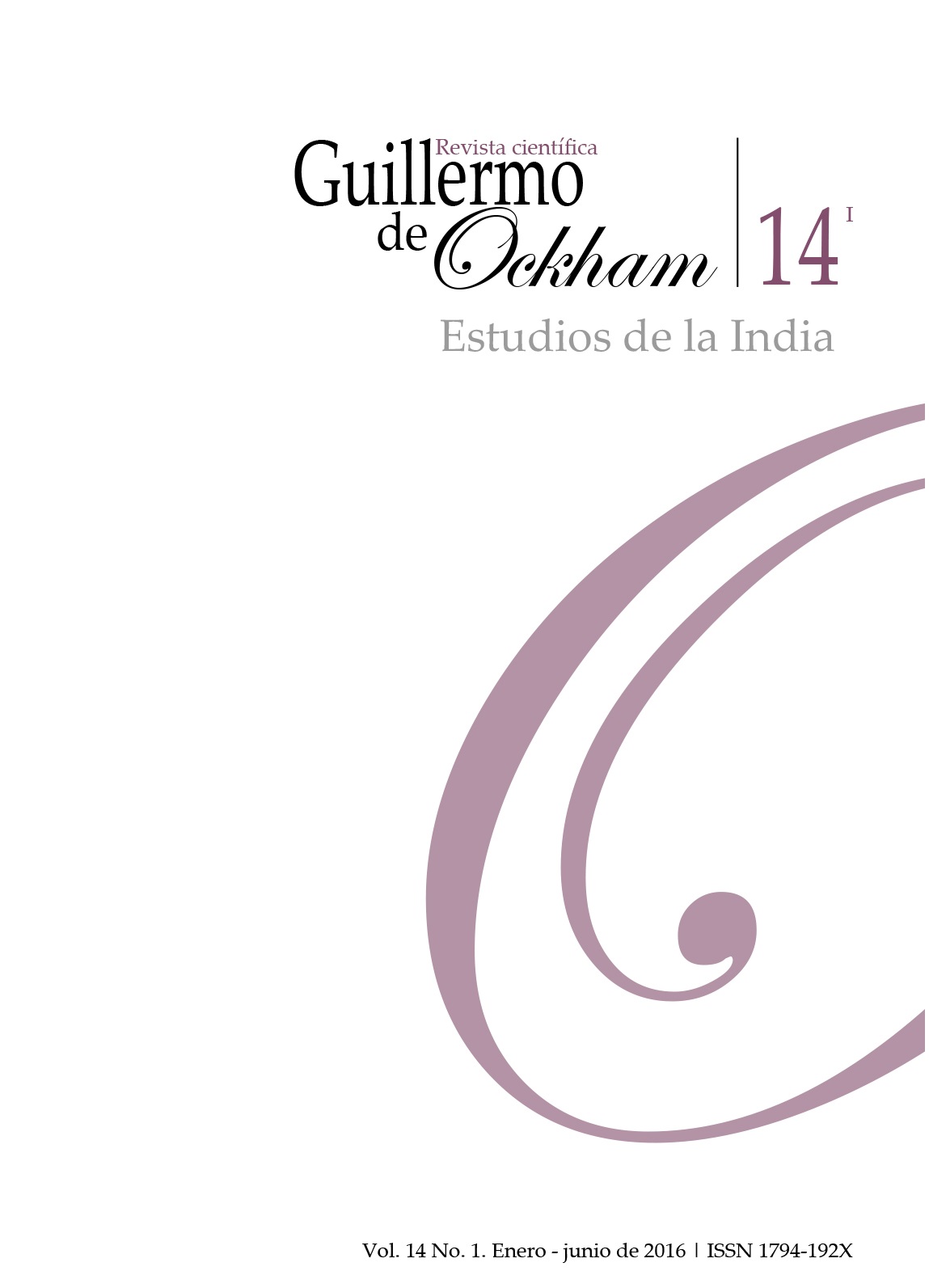The Revista Guillermo de Ockham provides an immediate and open access to its content, based on the principle of offering the public a free access to investigations to provide a global interchange of knowledge.
Unless otherwise established, the contents of this journal has a license with Creative Commons Attribution-NonCommercial-NoDerivatives 4.0 International (CC BY-NC-ND 4.0) http://creativecommons.org/licenses/by-nc-nd/4.0/
- Attribution: You must give appropriate credit, provide a link to the license, and indicate if changes were made. You may do so in any reasonable manner, but not in any way that suggests the licensor endorses you or your use.
- NonCommercial: You may not use the material for commercial purposes.
- NoDerivatives: If you remix, transform, or build upon the material, you may not distribute the modified material.
- No additional restrictions: You may not apply legal terms or technological measures that legally restrict others from doing anything the license permits.
Abstract
References
Āvaśyakaniryukti. Mambaī: Śrī Bherulāla Kanaiyālāla Koṭhārī Dhārmika Èrasṭa. Vi.Saṃ. 2038.
Balbir, N. (1993). Āvaśyaka-Studien. Introduction générale et Traductions. Stuttgart: Franz Steiner.
Ballanfat, M. (1997). Les matérialistes dans l’Inde ancienne. Traduction inédite du sanscrit, notes et commentaire. Paris – Montréal: L’Harmattan.
Bhattacharya, R. (1998). On lokāyata and lokāyatana in Buddhist Sanskrit. Annals of the Bhandarkar Oriental Research Institute, 79, 231-235.
Bhattacharya, R. (1999). Ajita Kesakambala: nihilist or materialist? Journal of the Asiatic Society of Bengal, 41(1), 74-83.
Bhattacharya, R. (1999a). Paurandarasūtra revisited. Journal of Indian Philosophy, 27(5), 485-497.
Bhattacharya, R. (2000): The significance of lokāyata in Pali. Journal of the Department of Pali, 10, 39-46.
Bhattacharya, R. (2002) .Cārvāka fragments: a new collection. Journal of Indian Philosophy, 30, 597-640.
Bollée, W. (1977): Studien zum Sūyagaḍa. Die Jainas und die anderen Weltanschauungen vor der Zeitenwende. Textteile, Nijjutti, Übersetzung und Anmerkungen. Wiesbaden: Franz Steiner.
Bollée, W. (2002): The Story of Paesi (Paesi-kahāṇayaṃ). Soul and Body in Ancient India, a dialogue on materialism. Text, translation, notes and glossary. Wiesbaden: Harrassowitz. (Beiträge zur Kenntnis südasiatischer Sprachen und Literaturen, 8.)
Bronkhorst, J. (2003): Review of The Story of Paesi (Paesi-kahāṇayaṃ). Soul and body in ancient India: a dialogue on materialism, by Willem Bollée. Études Asiatiques / Asiatische Studien, 57(1), 237- 242.
Bronkhorst, J. (2007): Greater Magadha: Studies in the Culture of Early India. Leiden - Boston: Brill. (Handbook of Oriental Studies 2/19.) Reprint: Delhi: Motilal Banarsidass. 2013.
Bronkhorst, J. (2008). Udbhaṭa, a grammarian and a Cārvāka. In M. Kaul & A. Aklujkar (Eds.), Linguistic Traditions of Kashmir. Essays in memory of paṇḍit Dinanath Yaksha (pp. 281-299). New Delhi: D. K. Printworld.
Cakradhara: Nyāyamañjarīgranthibhaṅga. Ed. Nagin J. Shah. Ahmedabad: L. D. Institute of Indology. (L. D. Series, 35.)
Chattopadhyaya, D. (1959). Lokāyata. A study in ancient Indian materialism. New Delhi: People's Publishing House.
Chattopadhyaya, D. (1976): What is Living and What is Dead in Indian Philosophy. New Delhi: People's Publishing House.
Chattopadhyaya, D., & Gangopadhyaya, M. K. (1990). Cārvāka/Lokāyata. An anthology of source materials and some recent studies. New Delhi: Indian Council of Philosophical Research.
Demiéville, P. (1927). Sur la mémoire des existences antérieures. Bulletin de l'École Française d'Extrême-Orient, 27, 283-298.
Dikshitar, T. R. (Ed.). (1929). The Saṃnyāsa Upaniṣad-s with the commentary of Śrī Upaniṣad-Brahmayogin. Adyar, Madras: Adyar Library and Research Centre.
Filliozat, P. S. (1993). Caraka's proof of rebirth. Journal of the European Āyurvedic Society 3, 94-111.
Franco, E. (1987). Perception, Knowledge and Disbelief. A study of Jayarāśi's scepticism. Stuttgart: Franz Steiner Verlag Wiesbaden.
Franco, E. (1997): Dharmakīrti on Compassion and Rebirth. Wien: Universität Wien.
Franco, E., & Preisendanz, K. (1998). Materialism, Indian school of. Routledge Encyclopedia of Philosophy, 6, 178-181.
Franke, O. (1913): Dīghanikāya. Das Buch der langen Texte des buddhistischen Kanons. Göttingen: Vandenhoeck & Ruprecht.
Guṇaratna Sūri: Tarka-rahasya-dīpikā. See Haribhadra.
Haribhadra Sūri. (1981). Ṣaḍdarśanasamuccaya. Edited, with the commentaries Tarka-rahasya-dīpikā of Guṇaratna Sūri and Laghuvṛtti of Somatilaka Sūri, by Mahendra Kumar Jain. Second edition. New Delhi: Bharatiya Jnanpith Publication.
Haribhadra: Āvaśyakaniryuktiṭīkā. Mambaī: Śrī Bherulāla Kanaiyālāla Koṭhārī Dhārmika Èrasṭa. Vi.Saṃ. 2038.
Harivaṃśa. Cr. ed. Parashuram Lakshman Vaidya. Poona: Bhandarkar Oriental Research Institute. 1969.
Hillebrandt, A. (1916). Zur Kenntnis der indischen Materialisten. In. R. P. Das, F. S, Stuttgart (Eds.), Aufsätze zur Kultur- und Sprachgeschichte vornehmlich des Orients, Ernst Kuhn zum 70. Geburtstage am 7. Februar 1916 gewidmet von Freunden und Schülern (pp. 14-26). München: Kleine Schriften.
Hopkins, E. W. (1901). The Great Epic of India. Its character and origin. Calcutta: Punthi Pustak.
Jacobi, H. (1895). Jaina Sūtras, translated from Prākrit. Delhi: Motilal Banarsidass.
Jayanta Bhaṭṭa: Nyāyamañjarī. Vol. I. Ed. K. S. Varadacharya. Mysore: Oriental Research Institute. 1969.
Jayanta Bhaṭṭa: Nyāyamañjarī. Vol. II. Ed. K. S. Varadacharya. Mysore: Oriental Research Institute. 1983.
Jayarāśi: Tattvopaplavasiṃha. Ed. Sukhlalji Sanghavi and Rasiklal C. Parikh. Baroda 1940. (Gaekwad's Oriental Series, 87.) Reprint: Bauddha Bharati, Varanasi, 1987 (Bauddha Bharati Series, 20.)
Jayatilleke, K. N. (1963). Early Buddhist Theory of Knowledge. London: George Allen & Unwin.
Jha, G. N. (1900). Slokavartika. Calcutta: Sri Satguru Publications.
Jinabhadra: Viśeṣāvaśyakabhāṣya (with auto-commentary until verse 2318, followed by Koṭyārya's commentary). Ed. Dalsukh Malvania. Ahmedabad: Lalbhai Dalpatbhai Bharatiya Sanskriti Vidyamandira. 1966-68.
Kangle, R. P. (1965). The Kauṭilīya Arthaśāstra. Part III. Delhi: Motilal Banarsidass.
Kangle, R. P. (1969). The Kauṭilīya Arthaśāstra. Part II. Delhi: Motilal Banarsidass.
Kangle, R. P. (1972): The Kauṭilīya Arthaśāstra. Part I. Delhi: Motilal Banarsidass.
Kṛṣṇa Miśra: Prabodhacandrodaya. Ed. Pt. Ramanatha Tripathi Shastri. Varanasi: Chaukhamba Amarabharati Prakashan. (Chaukhamba Amarabharati Granthamala, 20.) The text is also found in Pédraglio, 1974.
Kumārila Bhaṭṭa: Ślokavārttika. Edited, with the commentary Nyāyaratnākara of Pārthasārathi Miśra, by Swāmī Dvārikādāsa Śāstrī. Varanasi: Ratna Publlications. 1978. (Ratnabharati Series, 3.)
Laṅkāvatārasūtra. Ed. P. L. Vaidya. Darbhanga: Mithila Institute. 1963. (Buddhist Sanskrit Texts, 3.)
Leumann, E. (1885). Beziehungen der Jaina-Literatur zu andern Literaturkreisen Indiens. In A. Leyde & E. J. Brill (Eds.), Actes du Sixième Congrès International des Orientalistes tenu en 1883 à Leyde.
Leumann, E. (1998). Kleine Schriften. Stuttgart: Franz Steiner.
MacQueen, G. (1984). The doctrines of the six heretics according to the Śrāmaṇyaphala Sūtra. Indo-Iranian Journal 27, 291-307.
MacQueen, G. (1988). A Study of the Śrāmaṇyaphala-Sūtra. Wiesbaden: Otto.
Meindersma, T. E. (1990). Paralokasiddhi in Carakasaṃhitā. Indologica Taurinensia 15-16. Proceedings of the Seventh World Sanskrit Conference. Leiden, Netherlands.
Meisig, K. (1987). Das Śrāmaṇyaphala-Sūtra. Synoptische Übersetzung und Glossar der chinesischen Fassungen verglichen mit dem Sanskrit und Pāli. Wiesbaden: Otto Harrassowitz.
Olivelle, P. (1992). Saṃnyāsa Upaniṣads. Hindu scriptures on asceticism and renunciation. NY-Oxford: Oxford University Press.
Olivelle, P. (2000). Dharmasūtras. The Law Codes of Āpastamba, Gautama, Baudhāyana, and Vasiṣṭha. Delhi: Motilal Banarsidass.
Pārthasārathi Miśra: Nyāyaratnākara. See Kumārila Bhaṭṭa.
Pédraglio, A. (1974). Un drame allégorique sanskrit: le Prabodhacandrodaya de Kṛṣṇamiśra. Paris: l'Institut de Civilisation Indienne.
Potter, K. H. (1977): Encyclopedia of Indian Philosophies, II: Indian Metaphysics and Epistemology, The tradition of Nyāya-Vaiśeṣika up to Gaṅgeśa. Delhi: Motilal Banarsidass.
Preisendanz, K. (1994). Studien zu Nyāyasūtra III.1 mit dem Nyāyatattvāloka Vācaspatimiśras II. Stuttgart: Franz Steiner.
Rao, K. P. (1997). Charvaka Darshan: Ancient Indian Dalit Philosophy. Madras: xxx.
Rhys-Davids, T. W. (1889). On Lokāyata. = Chattopadhyaya & Gangopadhyaya, 1990: 369-376.
Ruben, W. (1979). Wissen gegen Glauben. Der Beginn des Kampfes des Wissens gegen den/das Glauben im alten Indien und Griechenland. Berlin: Akademie-Verlag.
Sadānanda: Vedāntasāra. Edited, with introduction, translation and explanatory notes, by M. Hiriyanna. Poona: Oriental Book Agency. 1929.
Śaṅkara: Brahmasūtrabhāṣya. Edited, with the commentaries Bhāṣyaratnaprabhā of Govindānanda, Bhāmatī of Vācaspatimiśra, Nyāyanirṇaya of Ānandagiri, by J. L. Shastri. Delhi: Motilal Banarsidass. 1980. Reprint, 1996.
Sāyaṇamādhava: Sarvadarśanasaṃgraha. Edited, with an original commentary in Sanskrit, by Vasudev Shastri Abhyankar. Third edition: Bhandarkar Oriental Research Institute, Poona, 1978. (Government Oriental Series Class A, No. 1.)
Schopen, G. (1983). The generalization of an old Yogic attainment in medieval Mahāyāna Sūtra literature: some notes on jātismara. Journal of the International Association of Buddhist Studies, 6(1), 109-147.
Schrader, F. (Ed.). (1912). The Minor Upaniṣads critically edited: Saṃnyāsa-Upaniṣads. Madras: The Adyar Library.
Śīlāṅka: Sūtrakṛtāṅgavṛtti. In: Ācārāṅgasūtram and Sūtrakṛtāṅgasūtram, with the Niryukti of Ācārya Bhadrabāhu Svāmī and the commentary of Śīlāṅkācārya. Originally edited by Ācārya Sāgarānandasūrijī Mahārāja. Re-edited with appendices etc. by Muni Jambūvijayajī. Delhi: Motilal Banarsidass. 1978. (Lālā Sundarlāl Jain Āgamagranthamālā, vol. I.)
Slaje, W. (2007). Yājñavalkya-brāhmaṇas and the early Mīmāṃsā. In J. Bronkhorst (Ed.), Mīmāṃsā and Vedānta (pp. 115-158). Delhi: Motilal Banarsidass.
Solomon, E. A. (1978). Bhaṭṭa Udbhaṭa. Annals of the Bhandarkar Oriental Research Institute, (58-59), 985-992.
Steinkellner, Ernst (1961): “Die Literatur des älteren Nyāya.” Wiener Zeitschrift für die Kunde Süd- und Ostasiens 5, 149-162.
Steinkellner, E. (1984). Anmerkungen zu einer buddhistischen Texttradition: Paralokasiddhi. Anzeiger der phil.-hist. Klasse der Österreichischen Akademie der Wissenschaften 121, 79-94.
Steinkellner, E. (1985). Paralokasiddhi-texts. In S. Heirakuji (Ed.), Buddhism and its Relation to Other Religions. Essays in Honour of Dr. Shozen Kumoi on His Seventieth Birthday (pp. 215-224). Kyōto: xxxxx
Steinkellner, E. (1986): Dharmottaras Paralokasiddhi: Nachweis der Wiedergeburt; zugleich eine Widerlegung materialistischer Thesen zur Natur der Geistigkeit. Der tibetische Text kritisch herausgegeben und übersetzt. Wien: Arbeitskreis für Tibetische und Buddhistische Studien Universität Wien. (Wiener Studien zur Tibetologie und Buddhismuskunde, Heft 15.)
Steinkellner, E. (1988). Nachweis der Wiedergeburt. Prajñāsenas 'Jig rten pha rol sgrub pa. 2 Teile. Wien: Verlag der Österreichischen Akademie der Wissenschaften. (Österreichische Akademie der Wissenschaften, philosophisch-historische Klasse, Denkschriften 197. Band; Beiträge zur Kultur- und Geistesgeschichte Asiens, Nr. 1)
Thapar, R. (2002). The Penguin History of Early India. From the origins to AD 1300. London: Penguin Books.
Tucci, G. (1929). Linee di una storia del materialismo indiano. Roma: Accademia Nazionale dei Lincei.
Tucci, G. (1971). Opera Minora Parte I. Roma: Università di Roma
Uno, T. (1999). A debate between materialists and Jainas on the interpretation of Bṛhadāraṇyakopaniṣad 2.4.12. In N. K. Wagle & Olle Qvarnström (Eds.), Approaches to Jaina Studies: Philosophy, Logic, Rituals and Symbols (pp. 238-249). Toronto: University of Toronto.
Vācaspati Miśra: Bhāmatī. See Śaṅkara.
































